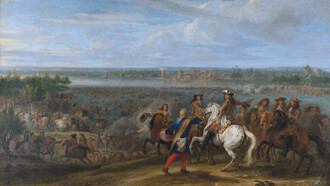The only reason for time is so that everything doesn't happen at once.
(Albert Einstein)
This insightful reflection by Einstein subtly cues us into the multidimensional and enigmatic nature of time, a theme that resonates deeply in our increasingly complex and interconnected world. As we delve into the intricacies of time through the lens of complexity science, artificial intelligence (AI), and the impact of media, we embark on a journey that transcends traditional boundaries, proposing a new paradigm in our understanding of this fundamental concept.
Saint Augustine once quipped, “What then is time? If no one asks me, I know what it is. If I wish to explain it to him who asks, I do not know.” This admission reveals the paradox of understanding time—a concept intuitively grasped yet profoundly challenging to define. Marcel Proust, in In Search of Lost Time, explored time's subjective nature through the prism of memory, while T. S. Eliot depicted its poetic malleability in Four Quartets. Each of these thinkers brings us closer to recognizing that time is not merely a linear progression but a richly layered collection of interwoven moments and potentialities.
The 20th-century philosopher Martin Heidegger expanded upon this in Being and Time, arguing that the essence of time cannot be separated from our consciousness and existence itself. He introduced the idea of time as a fundamental aspect of being human, where the past, present, and future are intricately connected. This view aligns closely with contemporary perspectives in complexity science, artificial intelligence, and media studies, each of which recognizes the profound interconnectedness between different temporal states.
As we explore the many facets of time through these perspectives, interconnected threads emerge, revealing that time is not a single, immutable entity but a concept deeply influenced by our perception, technology, and culture. In this exploration, we will see how complexity science illuminates the emergent properties of time, how AI enables predictive simulations that blur temporal lines, and how media reshapes our experience of the temporal landscape, all contributing to a multidimensional and thought-provoking understanding of time.
Time and complexity: an emergent phenomenon
Time, at its essence, isn't just a passive framework against which events occur but an emergent phenomenon shaped by complex interactions. Complexity theory, along with cybernetic perspectives like second-order cybernetics, provides crucial insights into how time operates within systems characterized by intricate relationships and unpredictable outcomes. In this light, time isn't strictly linear but is composed of interconnected sequences where causality and effect interact at various levels, revealing patterns that can only be understood through high-level analysis.
In second-order cybernetics, which acknowledges the observer as part of the system being observed, time emerges as a concept inherently linked to perception and cognition. This approach challenges the traditional objective view of time and instead emphasizes the role of feedback loops and self-regulating processes in shaping our experience of time. Cybernetics allows us to understand how systems regulate themselves through feedback and adaptation, which directly relates to our perception of temporal progression.
Moreover, the emergent properties of complex systems suggest that our perception of time itself is shaped by these underlying complexities. Just as a flock of starlings forms unpredictable patterns, time challenges conventional understanding when viewed through the lens of dynamic systems. It compels us to reconsider time beyond the steady tick-tock of the clock and recognize it as an emergent phenomenon driven by the interplay of dynamic forces within and between systems.
In the age of digital transformation—what I see as an infosomatic shift, where information integrates deeply with our somatic experience—time plays a pivotal role. The rapid exchange and analysis of information alter how we perceive temporal progression, with artificial intelligence offering unprecedented predictive capabilities and data analytics reshaping the flow of events. The ability of digital systems to process and simulate complex information expands the possibilities for understanding and anticipating temporal patterns, blurring the lines between the past, present, and future.
In this infosomatic era, time is no longer a rigid and linear concept but a dynamic construct shaped by data-driven feedback and predictive modeling. The interaction between complex systems, cybernetic regulation, and digital information opens new avenues for exploring the multidimensionality of time, revealing a phenomenon far richer and more intertwined with our perception and cognition than previously imagined.
The culturality of time
It’s no use going back to yesterday, because I was a different person then.
(Lewis Carroll, Alice in Wonderland)
Time isn't just a physical or biological phenomenon; it's deeply embedded in cultural context. Throughout human history, societies have attempted to define and organize time in ways that reflect their beliefs, traditions, and values. Cultural practices related to time reveal how different communities frame and shape their collective experience.
Einstein's observation that time exists to prevent everything from happening simultaneously provides a practical framework. Lewis Carroll's idea of the ever-changing self reflects the fluidity of identity and memory, indicating that our perception of time is directly tied to our subjective experiences and continuous personal transformation.
Rituals, artistic practices, and spiritual activities often anchor time in various ways that align with cultural perspectives. For instance, meditation practices such as those in Zen Buddhism and Yoga emphasize the present moment, transcending the linear passage of time. These practices slow or accelerate subjective time, creating what can be called "vertical" or "poetic" time. The meditative state roots the mind firmly in the present, where temporal flow seems to diminish.
Jorge Luis Borges captured this multidimensional aspect in his Labyrinths collection, noting, "Time is the substance I am made of. Time is a river that sweeps me along, but I am the river; it is a tiger that devours me, but I am the tiger; it is a fire that consumes me, but I am the fire." His metaphor underscores how deeply time is entwined with our perception of self, as well as the interplay between cultural narratives and our understanding of time.
In many indigenous cultures of North and South America, ritual dances dissolve time, creating collective ecstasy and transporting participants beyond linear temporality. This dynamic experience aligns with meditation, where the focus on the present diminishes the importance of linear time.
Thomas Metzinger's call for a new consciousness culture rooted in meditative experience challenges the notion of time as an unending flow. Instead, it advocates for cultivating the present. Exploring the culturality of time shows us that diverse practices and traditions offer a multitude of ways in which people relate to and perceive time. The intersection of inspiration, poetry, and spirituality with time reframes how we view the past, present, and future.
Artificial intelligence: simulating and predicting temporality
Artificial intelligence stands as a testament to humanity's quest to decode and simulate the essence of time. AI's capacity to process vast datasets and model potential futures offers a glimpse into a world where time can be both a variable to be manipulated and a dimension to be explored. Through predictive algorithms and simulation models, AI not only forecasts but also creates scenarios that enable us to peer into the temporal corridors of possibility, challenging the unidirectional flow of time from past to future.
The integration of AI in temporal analyses demonstrates how data-driven insights can collapse the future into the present, allowing us to anticipate and react not just to what has been, but to what might be. This proactive engagement with time disrupts the passive passage of moments, positioning AI as a pivotal tool in the reconfiguration of time.
Media and temporality: shaping perceptions and realities
In the realm of media, time finds a new expression. The rapid dissemination of information and the immediacy of digital interactions have cultivated an environment where time seems to contract and expand simultaneously. The media shapes not only our perception of time but also the pace at which we experience life. This mediatization of time challenges the rigidity of clocks, introducing a fluidity that mirrors the constant flux of the information age.
The pervasive influence of media extends to how societies construct and deconstruct temporal narratives. Through the lens of media, events are not fixed in time but are continuously rewritten and reinterpreted, illustrating the malleability of temporal understanding in the digital era.
Envisioning a multidimensional time landscape
The exploration of time through the lenses of complexity, artificial intelligence, and media reveals a multidimensional landscape where time is not a singular, unyielding stream but a multifaceted phenomenon that interacts with technology, society, and thought. This perspective, informed by cultural practices, scientific inquiry, and technological advances, encourages us to develop a nuanced understanding of time that embraces the interplay between the physical world and our collective and individual perceptions.
Einstein's assertion that "time exists so that everything doesn't happen at once" points to the practicalities of temporal separation, while Lewis Carroll's reflection on identity hints at the fluidity of time as we evolve and change. Borges' metaphor of being both the river and the tiger underscores how deeply time is connected to our sense of self and how our perception transforms as we move through life's labyrinth. Each of these viewpoints adds a layer to our understanding of how time weaves through the structures of society, science, and culture.
As the world undergoes rapid digital transformation, driven by data analytics and the predictive capabilities of AI, our perception of time is increasingly mediated by technology. The simulation of multiple futures through machine learning and data modeling allows us to anticipate and potentially shape what lies ahead, offering an unprecedented opportunity to rethink how we relate to time itself. In this infosomatic era, where information merges with the bodily experience, the boundaries between past, present, and future blur, creating an interconnected reality of simultaneous possibilities.
In this intricate web, time becomes a framework for both observation and creation, where each moment serves as a culmination and a beginning, constantly unfolding in the vast expanse of human experience. Our engagement with this multidimensional understanding of time offers a way to navigate the labyrinth of modern life, both intellectually and practically, allowing us to reflect, adapt, and thrive in an interconnected, digitally mediated world.
The significance of this exploration extends beyond academic curiosity. In science, business, and culture, a deeper understanding of time influences strategic thinking, technological innovation, and societal growth. And for those who wish to understand more about the philosophical connections behind my research, feel free to join me on Instagram at @tsvasman_sage, where the conversation continues.















